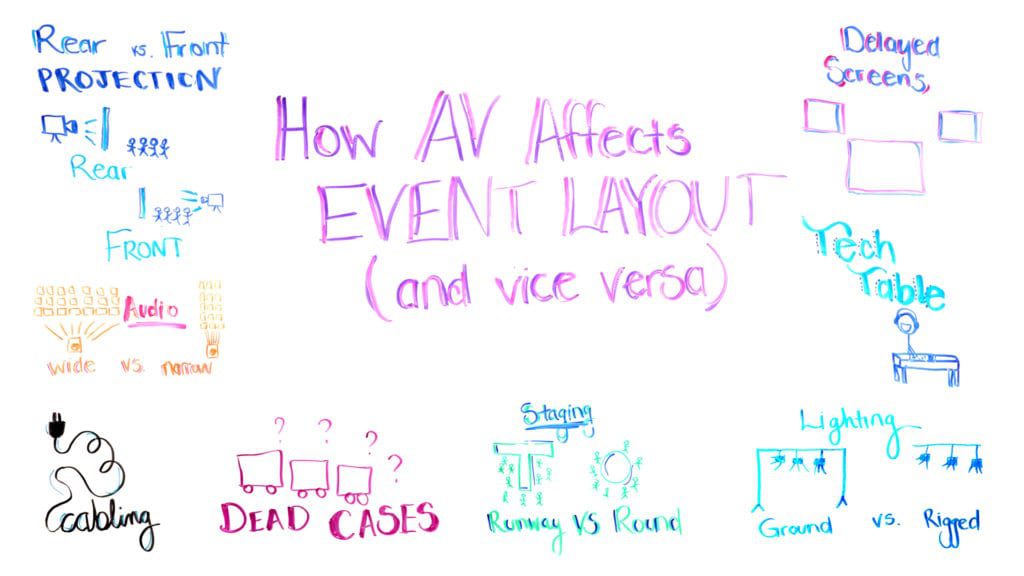You may be surprised how much your event layout will affect your event AV. With so many variables such as where are things going, the number of people, where you put your lighting and more, your layout can drastically impact your event AV and overall budget.
In today’s episode of Whiteboard Wednesday, Will Curran is going to walk you through how your event layout affects your event AV. He will discuss how the layout and AV are all part of the event planning puzzle and why you need to consider AV before selecting a layout. He will also give you tips on how everyone can work together to create the best event possible and address common issues we see when choosing event layouts. Watch below for a really interesting topic that we often overlook when planning!
And today we’re talking about how AV affects your event layout and vice versa, as well. Uh, obviously, with a lot of equipment and things being placed, it seems like AV is always working around what the layout to the room’s gonna be, where things have to be, making sure that we submit drawings and CAD designs, all that sort of stuff. We might be wondering, “Well, how do things really affect the layout, and how can I make sure that I’m planning my event properly?” And vice versa, how can the AV company, as well, plan around what you’re doing? So, I wanted to put together a rapid-fire list of tips and tricks when it comes to layouts and what gets affected when it comes to those certain items.
This is … by far, not an exhaustive list, but just at least a good starting point for you to get thinking.
 How Your Event Layout Affects Your Rear & Front Projection
How Your Event Layout Affects Your Rear & Front Projection
First, let’s talk about projection and how your event layout affects it. Either you’re projecting in the front of the screens or you’re projecting from the back. When you’re doing rear projection, you need to make sure you have a good amount of distance behind it for the space for the projector. Sometimes, you might be told that you’re going to have to do the front projection and that you don’t have enough room to do rear projection.
What that means is that you’ll have your projector out in the audience. If you’re not rigging that projector, the projector will actually sit in the audience. Consequently, you will need an unobstructed path between the projector and the screen, losing some floor space.
When thinking of event layout, always plan the distance that you need behind for rear projection. Ask your AV company how much space do you need behind the screen for you to be able to do rear projection. However, though, if you don’t have enough room for rear projection or to put the projector on the ground, you’ll have to rig the projector to the ceiling, which brings in rigging costs.
Think About Cabling In Advance!
At any given event, there are going to be a lot of cables. If you’re running power cables, for example, you need to know how is that cabling going to get done. Also, are there any restrictions for that venue? Many venues have a rule that you can’t have any cables across walkways, even if it’s taped down. At outdoor events where power is also more limited, you might need to run cabling from a lot of different places.
Event layout also has to do with the aesthetics of your event. Do you want to have cables running around? These things can depend on what the AV company decides and their plan of attack. However, though, it is very common for it to be forgotten.
Include Dead Cases In Your Event Layout
A dead case is an empty case. AV things come in cases, and then, we have to empty them and set up the equipment. Well, where are we going to put these empty cases? When it comes to your event layout, you want to find out where are all the dead cases are going. If you have a small event, a lot of it can be tucked in little small corners, behind the screens, and backstage. For larger shows, you might need a dedicated room for them, though.
You might be thinking to yourself, can’t I just have the company come and pick up those cases and take them back to the warehouse? While it’s possible, it’s not recommended since it comes with extra trucking costs. That truck is not going to sit there during the entire load-in time. It has to go make other deliveries. The trucks have to come back, get the equipment, take it all the way back to the warehouse, and then bring it all the way back during tear-down.
Instead, always think about where the dead cases will go. Your AV company will figure this out in their plan, but this really affects your event layout. If you end up having a lot of dead cases, you might end up being stick with a very crowded backstage. That might be something that your talent might not want or you might not have the room to do it at all.
Event Layout: Different Kinds Of Stages
When thinking of event layout, most people think staging. Will you have a traditional stage, do you want to do a runway, or do you want it round? It all affects the AV. You cannot use the same sound system, lighting, and video set up on a round stage and a runway, for example.
If you’re doing a runway, you can’t just light it from the front, but rather from both sides simultaneously. What that means is a lot more lighting as we want to make sure it has an even coverage. Same goes with the round setup. Instead of just having a couple of lights in the front, shooting one way, you have to light it 360 degrees, which then affects your AV and your costs. So, something to always keep in mind is that depending on how you want to do your staging, your AV system is going to get tweaked and moved around as well.
Ground Supported Lighting Vs Rigged Lighting
Lighting shifts based on the stage set up that you have and the layout that you’re deciding, but also, it depends on whether you’re gonna do what’s called ground supported lighting versus rigged lighting. So, this is a humongous topic that we talk a lot about it, the difference between ground supported and rigged lighting or in rigged sound systems, everything rigging related. But let’s say, for example, that you want to do everything ground supported because you wanna save on rigging costs, right? You don’t wanna have all those rigging points. It’s just an added cost. Oh, we’re gonna do everything ground supported. Well, if you’re trying to do your lighting in a certain way, it might be tough to do that.
So, for example, if you have a lot of lights that need to light up the stage, it might not be as easy as putting them on the edge of the room. So, you might have to put trussing and that ground supported setup in the middle of the room.
What that means is you’re all of a sudden having these gigantic stands and truss, and everything like that, out in the audience. You’re gonna have to save a little bit more room when it comes to that stuff. And what you might find is that you don’t wanna have that, right? You wanna make sure that you have a completely unobstructed path. Well, in that case, you might wanna opt-in for doing some rigging setup. That means you get to hang everything above the ceilings, and the floor’s completely clear. Well, what that means, as well, is that when you’re doing things ground supported, things are gonna be in the way. So, again, you can have this kind of trade-off. Sure, you save some money with ground supported, but then you might end up losing the space that you would get if you rigged it. So, something to keep in mind when it comes to your layout.
Wide Rooms Vs Narrow Rooms
All right, next thing has to do with audio, and that has to do with wide rooms versus of a narrow room. So, a lot of times, um, whenever we come in to do an AV setup, usually the client’s already decided how they wanna have the room laid out. They say, “We wanna do it wide” or “We wanna do it narrow”. Well, this affects the layout and the audio design an extreme amount. So, for example, if you do it the wide way, so, let’s say, for example, in this case, we have three rows by … What is this? One, two, three, four, five, six, seven columns wide. But in this case, we have seven rows deep by three columns wide. Well, you might be thinking to yourself, “Well, it’s the same amount of seats.” Well, what that means is the audio’s gonna get covered in two different ways. With this wide setup, you might wanna put four speakers right on the ground facing the covers, and that might be enough so the people in the back, the third row, are able to hear.
However, let’s say, for example, you’re like, well, we don’t need four speakers to go wide, so we can do only two, right? Well, no. Now, the speaker on lasts to about the third row, so these last two couple of rows are gonna have some hard times hearing. So, what that means is, you’re gonna have to put speakers halfway through. And we’re gonna talk about delay screens and delay audio in just a second. But what this means is that the layout to the audio’s gonna have to be done in a different way. Um, and so what that means is, depending on which way you do it might affect the AV. Kinda seeing how it’s …. You know, every little detail seems to affect it. So, that’s always something to keep in mind.
What we’ve also found, as well, is, for example, if you’re doing it wide, you might need to put two screens on either side as well going into video. Whereas the narrow, you might be able to get away with one screen versus … ‘Cause on this end, they can’t see this screen right over here, so they need to have a screen closer to them, or maybe that’s too close, so we want them to look a little further away. There’s a lot of different changes that can kinda happen. But that’s something to really keep in mind is talk to your AV company about what layout would they recommend for your setup, and don’t quite commit to 100% until you’ve decided about how the AV’s gonna get affected.
Delayed Screens and Audio
All right, so I teased it a little bit, but we talked a little bit about delay screens, and this also goes for delay audio. You might be thinking to yourself, “What does this mean delayed video? Like, when I … someone waves their hand five seconds later, you know, I see the delay?” No, not at all. Well, I guess kind of. But the idea of delay is this idea that you might have your main screens. For example, let’s say this is your main screen for your setup. Well, if your room is very long and narrow, or long period, and there’s a lot of rows of seats, let’s say, there are a thousand people, then there are a thousand people behind them. Well, those first thousand might be able to see this main screen really, really well. But the people in the back are squinting, then go, “I can’t see. It’s too far away.” So, you might end up doing is adding another set of screens halfway back through the room. So, therefore, you have the one in the front and then one halfway in the back, so the people can see in the back. Pretty simple, right?
Well, by having a very long room, you’re, again, you might have to a need for these delay screens. Well, the same goes with audio. The audio sound system might be designed that it can cover the first thousand people in the room, but you might need an additional audio delayed and a delay audio system, just like you need delay screens that halfway pack the room covering that back as well. So, it’s always something to keep in mind, and this goes for the wide setup as well. So, for example, let’s say instead of having, you know, seven rows by three rows, it’s more like, like 70 rows by, you know, five rows, and this one is five rows wide by 70 deep, right? So, what ends up happening is maybe this wide setup you might not need delay screens because it’s close enough for people to see the screens. But on the narrow side, the people in the back are gonna have trouble seeing, so we need to add a delay. So, that’s always something to keep in mind. Your AV company’s always gonna recommend what’s best for you, but keep in mind, with bigger audiences, you’re technically gonna probably need some delay screen and delay audio as well.
Tech Table
So, all right, on to the last one, which seems like the super minor detail that gets forgotten until the last minute, is the tech table, also known as the front of house or FOH. That’s where all the technicians are mixing the boards, they’re on a computer doing their thing, and usually, it’s at the back of the room. So, therefore, you know, let’s say you are … you’re the stage. I’m in the back of the room. Sometimes in the back corner, sometimes it’s in the back center, sometimes for really big rooms it might be right in the middle of the room, or maybe it’s in the middle of the room off to the side. There’s a lot of different places that it can go. Well, it always seems that it’s forgotten, and we don’t quite talk to the AV company about what would be best for this.
So, when it comes to deciding that front of house position, talk to your AV company. They’re gonna have a specific place they wanna be, and just keep in mind that, yes, your AV company should be flexible with you to hopefully, uh, work with you to find the position that not only looks good and isn’t blocking what you need, but let’s say, for example, if you’re doing a big concert setup. You’re having a great band come and play, they might not wanna have the front of house positioned off to the side. The reason why is they wanna get as close as possible to what the audience hears and sees. And the reason why is that they’re controlling lights, they’re controlling video, they’re controlling audio. The more they can hear what the audience hears, the more they can tune it the right way and make it look exactly like they want the audience to look.
So, with that being said, talk to your AV company. Where do you want this tech table? A lot of times, it’s a little small riser, sometimes 12 inches, maybe 24 for a larger event, a series of tables, and then, also what they’ll usually do is also drape 100% around it. So, you always wanna factor this into your layout in where you’re gonna put these things because the last thing you wanna do is have to figure out where you’re gonna put this gigantic deck. And again, this also depends event to event, because more engineers, maybe the bigger the event, the bigger the tech table area is gonna need to be. Uh, maybe they wanna do a double-decker area. Maybe they want it wider versus narrower, all these things like that. They’ll always work with you, and they’ll always let you know how much they need. But this is a great question to ask when planning your layouts as well.
Conclusion
All right, that’s everything when it comes to layouts. No, I’m just kidding, not everything, but these are at least some things to get your mind thinking about when it comes to your layouts and where do things need to go when it comes to your AV. So, next time you’re planning your layout, think about a couple of these things, where are things going, how does this relate to AV, and put it in as part of your larger puzzle when it comes to your layouts and everything. Your AV company should work with you and give you good feedback, but the idea to know is that, that everyone wants to work together to make the best possible event.
So, with that being said, if you thought this video was awesome, I would love if you gave it a thumbs up right down below. If you thought it was poopy and didn’t like it very much, give us the thumbs down, and leave us in a comment.
Resources










